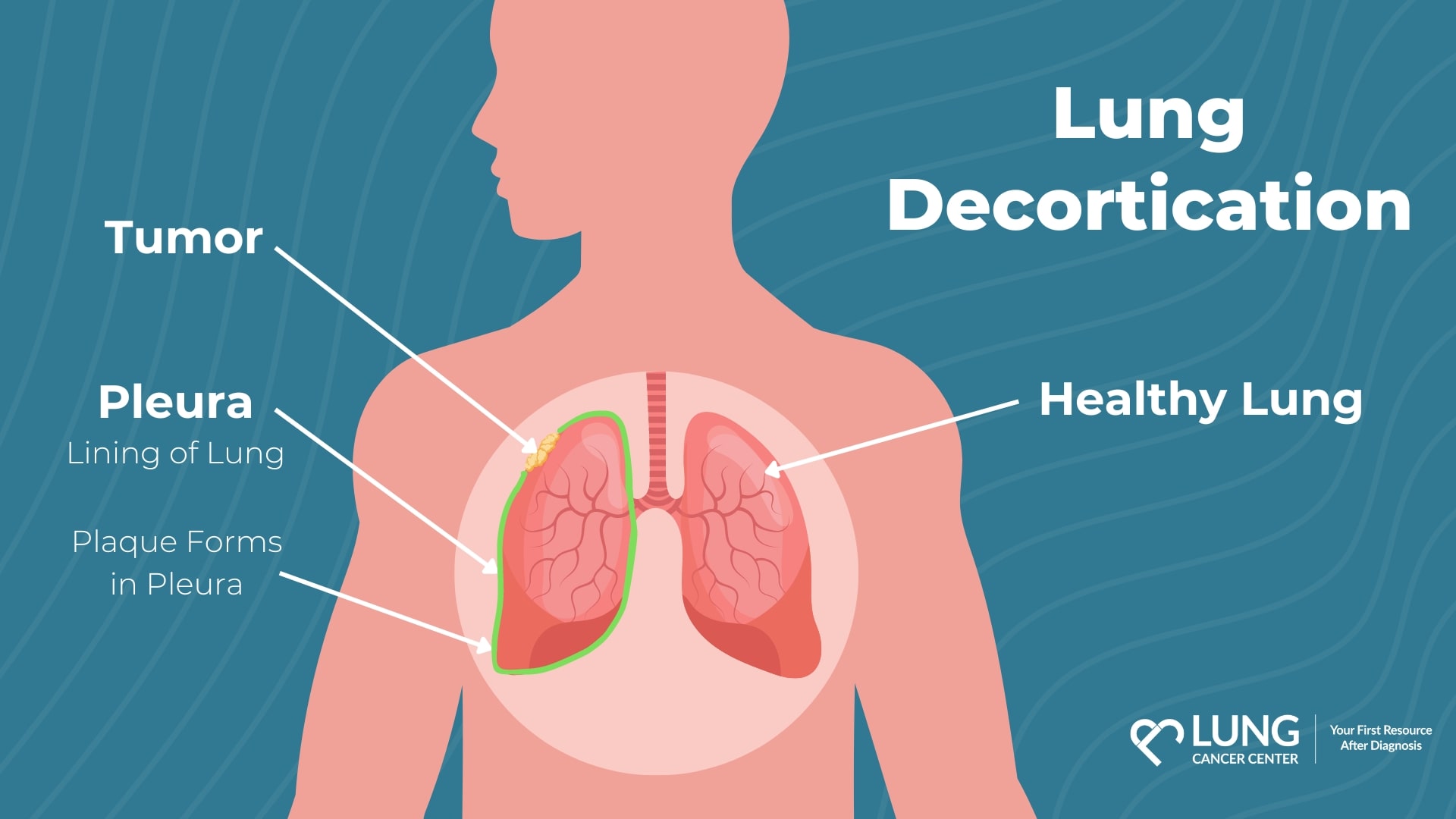What is Lung Decortication?
Lung decortication is a surgical procedure that removes the fibrous tissues in the pleural lining. The pleural space is found between the lungs and the chest wall and is lined for lubrication. Often referred to as a pleurectomy, this surgery is used to treat a condition known as pleural effusion and is often used as a treatment for mesothelioma.


What is a Lung Decortication?
Decortication is a surgical procedure that removes fibrous tissue from the pleura space. The pleura area, located between the chest wall and the lining of the lungs, can fill with fluid that continues to build up. Built-up fluid around the lungs is a condition known as pleural effusion, and decortication is a typical treatment for mesothelioma and pleural effusion.
Why is Lung Decortication Done?
Pleural mesothelioma is a cancer that forms in the lining of the lungs. This dangerous cancer can spread to surrounding areas such as the lungs, lymph nodes, and diaphragm. Doctors typically treat mesothelioma with chemotherapy, radiation, and surgery. There are several varieties of mesothelioma surgery that have varying success rates and usage. A lung decortication surgery is often used to treat pleural mesothelioma as the cancer forms, specifically in the pleura area. A lung decortication is a surgery that addresses the pleura space, separating it from other mesothelioma surgeries.
Medical professionals often use lung decortication in conjunction with a mesothelioma pleurectomy (P/D). Decortication removes cancerous tumors, and a pleurectomy removes the lining around the lungs. A pleurectomy with decortication is a common treatment avenue for patients with pleural mesothelioma.
Surgeons often debate whether to use a P/D or perform a more invasive procedure: extrapleural pneumonectomy (EPP). An EPP surgery removes the cancerous part of the pleura, pericardium, or diaphragm. The two surgeries have similar survival rates; however, P/D has fewer complications and results in a better quality of life.
Is Lung Decortication a Major Surgery?
Lung decortication is a major two-part procedure that involves opening the chest cavity and removing the pleural lining and other cancerous tissues. The surgeon also removes any tumor masses from the surface of the lung and chest area. The lung surgery takes several hours to complete but can increase your chances of survival and reduce symptoms.
When patients undergo a P/D, 90% experience reduced symptoms, and the decortication risks are low. Only 1% of patients pass during or immediately after the procedure. Lung decortication complications typically involve a prolonged air leak or breach.
Video Assisted Thoracoscopic Surgery (VATS)
A less invasive surgical procedure for patients is called a video-assisted thoracoscopic surgery (VATS) pleurectomy. This surgery inserts a tiny camera and surgical instruments into the chest through a small incision. The decortication thoracotomy combination is a reasonable alternative for higher-risk patients with pleural mesothelioma. Additionally, patients undergoing a VATS decortication procedure have better short-term outcomes than those undergoing curative attempts at surgery.
Many surgical procedures, such as lung decortication, are often part of a multimodal treatment. Multimodal treatment plans involve the combination of multiple therapies, such as chemotherapy or radiation therapy. Combination treatment works to eliminate all cancer cells and improve a patient’s prognosis.
Decortication Procedure
The primary goal of a decortication procedure is to remove tumors or fibrous tissues from the lung’s surface. Decortication processes typically involve the surgeon:
- Removing the layer of the pleura closest to the lungs.
- Extracting any tumor tissue from the lungs.
- Removing any cancerous lymph nodes.
- Separating healthy and cancerous tissues and reconstructing the diaphragm.
- Closing all incisions.
Pleurectomy Procedure
A pleurectomy procedure removes the lining around the lungs, the pleura. A pleurectomy surgery involves steps such as:
- Prepping for surgery and administering anesthesia.
- Making an incision between the ribs, a thoracotomy.
- Removing the sixth rib to access the pleural space.
- Detaching the parietal pleura from surrounding structures.
- Removing tumors from surrounding structures.
Treatment Recovery Process
After receiving a lung decortication surgery, recovery can seem like a long, daunting road. It can take several weeks and minimal activity to fully recover from start to finish. The surgery recovery time in the hospital lasts two weeks, and doctors will monitor you closely. Initial side effects include small amounts of blood loss and air leaks. You will likely experience side effects such as lung pain and shortness of breath; therefore, your doctors will encourage breathing exercises and similar therapies.
After being discharged from the hospital, recovery typically lasts several additional weeks. You may be eligible for complementary therapies such as pulmonary rehabilitation if experiencing severe side effects. Avoid heavy lifting and vigorous exercise after surgery to ease breathing and keep side effects under control. While in recovery, you may develop questions about your prognosis, future treatment options, and how to make medical payments.
Lung Cancer Center can help you breathe easier during this challenging time. Determine how to fight a mesothelioma diagnosis by accessing your free Lung Cancer Guide today.


